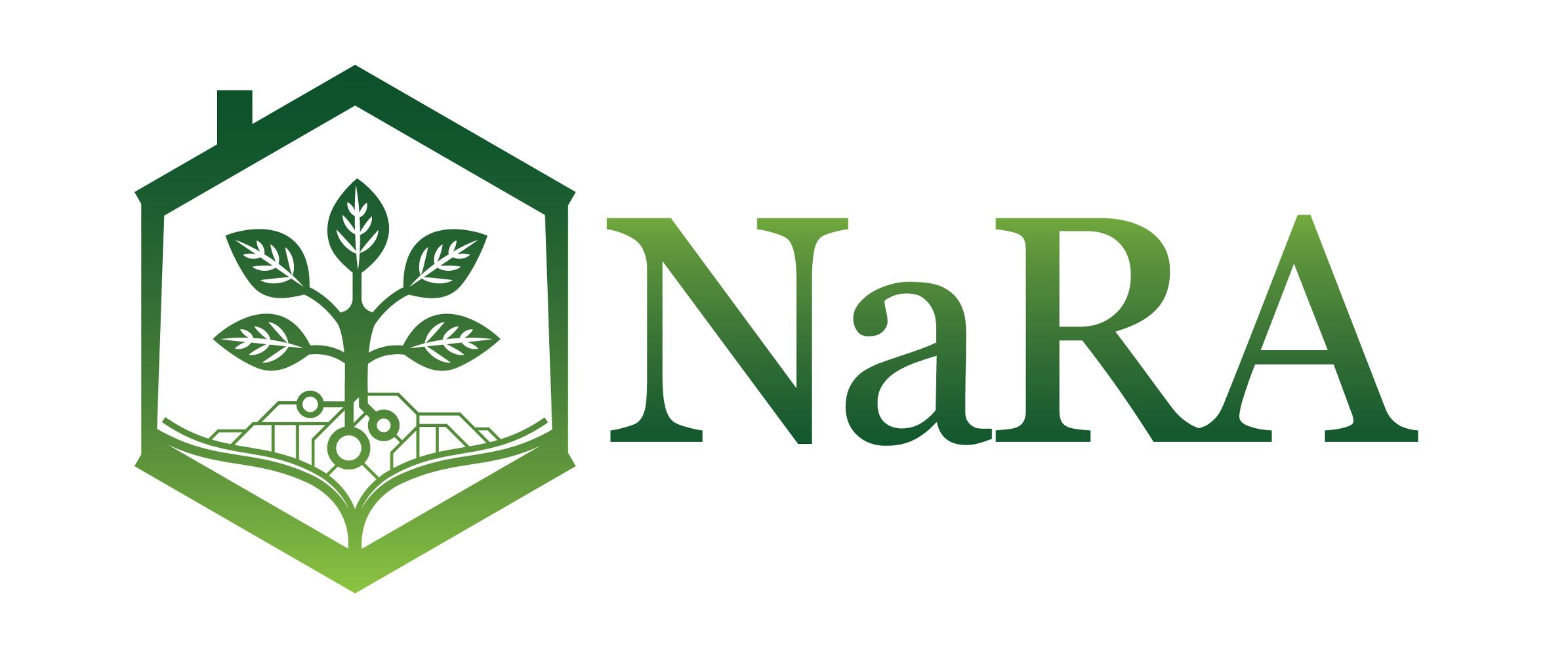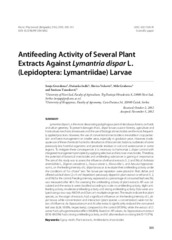Antifeeding Activity of Several Plant Extracts Against Lymantria dispar L. (Lepidoptera: Lymantriidae) Larvae
Antifiding aktivnost nekoliko biljnih ekstrakata za gusenice Lymantria dispar L. (Lepidoptera: Lymantriidae)
| dc.contributor.author | Gvozdenac, Sonja | |
| dc.contributor.author | Indjic, Dusanka | |
| dc.contributor.author | Vukovic, Slavica | |
| dc.contributor.author | Grahovac, Mila | |
| dc.contributor.author | Tanaskovic, Snezana | |
| dc.date.accessioned | 2015-11-08T14:55:53Z | |
| dc.date.available | 2015-11-08T14:55:53Z | |
| dc.identifier.uri | http://arhiva.nara.ac.rs/handle/123456789/1457 | |
| dc.description.abstract | Lymantria dispar L. is the most devastating polyphagous pest of deciduous forests, orchards and urban greenery. To prevent damages that L. dispar larvae cause in forestry, agriculture and horticulture, mechanical measures and the use of biological insecticides are the most frequently applied practices. However, the use of conventional insecticides is inevitable in crop protection and forest management on smaller areas, especially in gradation years. However, inadequate use of these chemicals has led to disturbance of biocoenotic balance, outbreaks of some previously less harmful organisms and pesticide residues in soil and watercourses in some regions. To mitigate these consequences it is necessary to harmonize L. dispar control with integrated management principles by applying selective and less toxic insecticides. Therefore, the potential of botanical insecticides and antifeeding substances is gaining in importance. The aim of this study was to assess the influence of ethanol extracts (1, 2 and 5%) of Ambrosia artemisiifolia L., Erigeron canadensis L., Daucus carota L., Morus alba L. and Aesculus hippocastanum L. on the feeding intensity of L. dispar larvae, i.e. to evaluate their antifeeding activity under the conditions of “no-choice” test. Ten larvae per repetition were placed in Petri dishes and offered oak leaf slices (2 x 9 cm2/repetition) previously dipped in plant extract or ethanol (1, 2, and 5%) for the control. Feeding intensity, expressed as a percentage of consumed leaf area (%), was measured after 48 h. For assessing the antifeeding activity of plant extracts AFI was calculated and the extracts were classified according to scale: no antifeeding activity, slight antifeeding activity, moderate antifeeding activity and strong antifeeding activity. Data were analyzed using a two-way ANOVA and Duncan`s multiple range test. The results indicate that plant species, i.e. the origin of extracts, had a significant influence on the feeding intensity of L. dispar larvae, while concentration and interaction (plant species x concentration) were not factors of influence. Ae. hippocastanum and M. alba extracts significantly reduced the consumed leaf area (6.24, 18.93%, respectively), compared to the control (97.59%), while the extract of D. carota had a phagostimulative effect (98.88%). Based on AFI values, Ae. hippocastanum extract (87.10-89.05%) had a strong antifeeding activity, and M. alba medium-to-strong (64.33-71.37%). | en |
| dc.description.abstract | . je ekonomski najznačajnija polifagna štetočina listopadnih šuma, voćnjaka i urbanog zelenila. Mehaničke mere i upotreba bioloških insekticida su najčešće primenjivane mere zaštite s ciljem smanjenja šteta koje prouzrokuju gusenice svojom pojavom. Međutim, na manjim površinama, a posebno u godinama gradacije, neizostavna je upotreba konvencionalnih insekticida u zaštiti bilja i šumarstvu. Višegodišnja neodgovarajuća primena ove grupe insekticida je dovela do narušavanja ravnoteže u biocenozi, prenamonženja ranije manje štetnih organizama, pojave rezistentnosti štetnih vrsta na insekticide, kao i prisustva rezidua pesticida u zemljištu i vodotokovima. U cilju smanjenja štetnih posledica neophodno je uskladiti suzbijanje sa principima integralnog pristupa smanjenju brojnosti gubara, primenom selektivih i manje toksičnih insekticida. Naime, sve više se istražuje potencijal botaničkih insekticida i antifiding sredstava. Cilj ovog rada je bio da se proceni uticaj etanolnih ekstraktata Ambrosia artemisiifolia L., Erigeron canadensis L., Daucus carota L., Morus alba L. i Aesculus hippocastanum L. na intenzitet ishrane gusenica L. dispar, kao i njihove antifiding aktivnosti u uslovima “no-choice” testa. Ogled je realizovan u laboratorijskim uslovima. Po 10 larvi po ponavljanju je stavljeno u petri-posude i ponuđena su im po dva isečka lista hrasta (2 x 9 cm2/ponavljanju), potopljena u biljne ekstrakte, odnoso u 1, 2 i 5% rastvor etanola u kontroli. Intenzitet ishrane, iskazan preko procenta konzumirane površine, je meren nakon 48 h. Za procenu antifiding aktivnosti, izračunat je AFI (antifeeding index), a biljni ekstrakti su kategorizovani prema već utvrđenoj skali: nema, slabo, srednje i jako antifiding dejstvo. Podaci su statistički obrađeni dvofaktorijalnom analizom varijanse, uz primenu Dankanovog testa višestrukih poređenja. Rezultati rada ukazuju da je značajan uticaj na konzumiranu površinu lista imalo poreklo biljnog ekstrakta, dok koncentracija i interakcija dva faktora (biljna vrsta x koncentracija), nisu statistički značajno uticale na vrednost konzumirane površine. Ekstrakti Ae. hippocastanum i M. alba statistički su značajno smanjili procenat konzumirane površine (6.24, 18.93%, respektivno) u poređenju sa kontrolom (97.59%), dok je ekstrakt D. carota ispoljio fagostimulativni efekat (98.88%). Na osnovu AFI vrednosti, ekstrakt Ae. hippocastanum (87.10-89.05%) je ispoljio jaku antifiding aktivnost, a M. alba srednju do jaku (64.33-71.37%). | sr |
| dc.subject | Gypsy moth | en |
| dc.subject | Plant extracts | en |
| dc.subject | Antifeedants | sr |
| dc.subject | Insecticides | en |
| dc.subject | Gubar | sr |
| dc.subject | biljni ekstrakti | sr |
| dc.subject | antifiding | sr |
| dc.subject | insekticidi | sr |
| dc.title | Antifeeding Activity of Several Plant Extracts Against Lymantria dispar L. (Lepidoptera: Lymantriidae) Larvae | en |
| dc.title.alternative | Antifiding aktivnost nekoliko biljnih ekstrakata za gusenice Lymantria dispar L. (Lepidoptera: Lymantriidae) | sr |
Files in this item
This item appears in the following Collection(s)
-
VOL 27 *No.4
http://www.pesting.org.rs/2012.php



